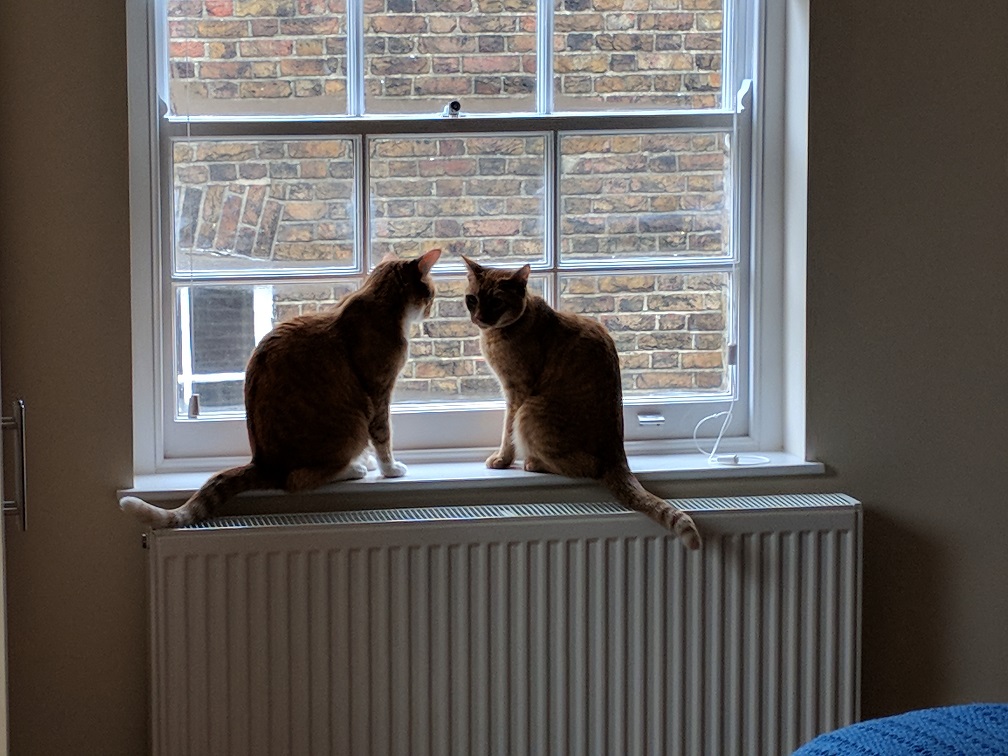Do you have furry friends who will be making the trek across the world with you? Awesome! I have to say that having our buddies Jameson and Tigger with us made the UK feel more like home very quickly. However, it was also one of the greatest stresses of our move. And that’s because we were doing it all ourselves, and the websites that help are all government websites that can bury the most important information.

Moving pets requires serious planning and attention to dates in a way that rivals the visa process. And the worst case scenario is you could show up to the airport on the day of your flight and not be allowed to drop off your pets. So you’ve got to plan ahead.
I’m going to share our experience with our cats. The shots needed likely differ with dogs, but the timing should be the same.
First things first: animals cannot enter the UK in the cabin of the plane. So you need to make your peace with the fact that your buddies are going to be in cargo for a long time. Like, a very long time. And that’s okay – there are staff dedicated to making sure your furry friends are taken care of. But it’s going to be traumatic for them as well, and there isn’t any way around it (unless it’s a service animal, and even then there are very strict rules).
Your pet needs to be micro-chipped. If you adopted your pet, they are probably already micro-chipped, but unfortunately it’s possible the microchip your pet has isn’t the right one. We rescued our two cats, and they were fixed and chipped, but using a different technology than the UK uses. You need to check that your chip has 15 digits; if not, it’s not the right one. Set up a vet appointment and get a new chip inserted.
Your pet also needs to be vaccinated against rabies. Which I’m sure she is. BUT. The rabies vaccine only counts if it’s given after the UK-compatible microchip has been inserted (same day is fine). I did find a section of the USDA website that implied you could provide some other paperwork to show a previous rabies vaccine counted, but we didn’t want to risk it. So I suggest that at the same appointment you get them micro-chipped you also get them re-vaccinated for rabies.
If you’re us, the vet tech will not realize that’s why you’re doing the rabies vaccine earlier than necessary (even though it’s been explained multiple times), and simply not administer the vaccine. But it is critical that they do it (we fixed it later that day – poor cats, two vet trips in five hours!), AND it must be done MORE THAN 21 DAYS BEFORE YOU’LL ENTER THE UK. That is key. I recommend doing it well before then, but no matter what, it must be more than three weeks before you’ll arrive.
Because your animals will be traveling in the cargo hold, they need to be in a very secure kennel, and they can’t travel in the same one. I recommend following the instructions on the website of the airline you’ll be using. Our cats were in the 200 size, which seems huge until you realize they need space to move around and stretch.
I also recommend purchasing the pet travel kit (available on Amazon), which includes metal bolts, food and water trays, and a piddle pad. Even if you purchase the kennel that is recommended by the airline, it will still likely have plastic screws and bolts connecting both halves, and the airlines require metal ones. So get the kit. They’ll also require an absorbent lining, so stick the piddle pad underneath a towel.
And then just leave the kennels out, for at least a month before the trip. Put food and water in the dish. Let the animals get used to the kennels and, if possible, don’t use them for anything else. You don’t want them to associate it with a trip to the vet or anything else stressful.
We used United Airlines for our trip. A few things to keep in mind:
- It’s fucking expensive. Each cat was about $700, plus the fee once we arrived in the UK (more on that)
- There are very specific rules about the time the cats need to arrive before the flight and, if you have a connection, the time in between. Our flight left at 6:55 AM; we had to drop our cats off at cargo at 3:30 AM. That is not a typo. And we had a connecting flight, so there needed to be at least three hours between connections because of the international component.
- You will need to work with a pet importer on the other end. I strongly recommend you go with whomever the airline uses, because that’s their partner and they do this on a daily basis. It might be a little more expensive, but these are your family members; do you really want to screw around with this?
One thing we learned that was pretty cool is that pets are the very last thing that gets loaded onto the plane and the very first thing that gets unloaded. When we landed in Houston, we had barely taken our seat belts off when we saw a van with “Pet care” on the side pulling away from our plane. They get the animals to a safe and comfortable place to reduce their stress. Awwwww.
Okay, back to the process of getting your animals approved and avoiding quarantine. No more than ten days (check your airline on the specifics, but they mean business – 11 days and you’ll be rejected if their rules say ten) before travel, your animals will need to be seen by a USDA approved vet, who will complete a pet health certificate. You might see mention of a pet passport, but that only works within the EU. They’ll do a quick check of your animal, and then fill out this really complicated form and emboss their seal in it. If you have fewer than five pets, they’ll all be listed on the same certificate. You can find the details here.
Now, here’s the part that almost totally fucked us over: you THEN need to send this certificate, along with proof of micro-chipping and proof of rabies shot (all signed in BLUE INK) to your regional USDA office, which needs to check it, emboss the certificate, and send it back to you.
Are you thinking what I am? That you can’t do the vet appointment until ten days before you arrive in the UK, but you also have to send it somewhere? Yeah. We didn’t realize it until the morning of the vet visit. Luckily the regional USDA office is only an hour from where we lived, so we got the money order (that’s what they need) for the certificates and paid for express overnight delivery, and pre-paid for express overnight return delivery. We sent it on Wednesday and got it back Friday morning, which was good, because our flight was Tuesday. SO MUCH STRESS.
If possible, and if your USDA office is nearby, make an in-person appointment. Then you can just drive over and get it done, instead of spending a couple of days hoping that Fed Ex doesn’t manage to mess it up. But make the in-person appointment well in advance – they book up quickly.
I mentioned above that you need to work with a pet importer to handle the animals when they arrive. They will have some paperwork that you need to complete, and they will be your contact when you arrive in the UK, delivering your pets to animal customs and letting you know when they are available for pick up. When you book your cats through the airline, get the information on who they recommend you use.






